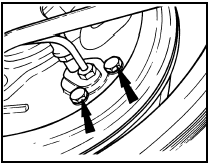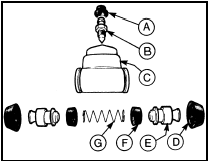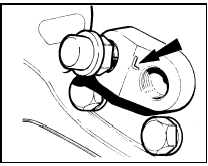Rear wheel cylinder - removal, overhaul and refitting
Note: Before starting work, refer to the warning at the beginning of Section 2 concerning the dangers of asbestos dust, and to the warning at the beginning of Section 3 concerning the dangers of hydraulic fluid.
Removal
1 Remove the rear brake shoes, as described
in the preceding Section.
2 Disconnect the fluid pipeline from the wheel cylinder and cap the end of the pipe to prevent loss of fluid.
3 Unscrew the two bolts which hold the wheel cylinder to the brake backplate and remove the cylinder with sealing gasket (see illustration).

6.3 Rear wheel cylinder retaining bolts (arrowed)
Overhaul 4 Clean away external dirt and then pull off the dust-excluding covers.
5 The pistons and seals will probably shake out. If they do not, apply air pressure (from a tyre pump) at the inlet hole to eject them (see illustration).

6.5 Exploded view of the rear wheel cylinder
A Dust cap
B Bleed screw
C Wheel cylinder
D Dust excluder
E Piston
F Piston seal
G Spring
6 Examine the surfaces of the pistons and the cylinder bores for scoring or metal-to-metal rubbing areas. If evident, renew the complete cylinder assembly.
7 If the cylinder is to be renewed note that any one of three different sizes may be fitted according to model and year. The wheel cylinders are identified by a letter stamped on the rear face which corresponds to the following (see illustration):

6.7 Wheel cylinder identification letter location (arrowed)
Letter “T” = 22.2 mm diameter cylinder Letter “L” = 19.05 mm diameter cylinder Letter “H” = 17.78 mm diameter cylinder Ensure that the new cylinder obtained is the same as the one removed and more importantly, is the same as the cylinder on the other rear brake.
8 Where the components are in good condition, discard the rubber seals and dust excluders and obtain a repair kit.
9 Any cleaning should be done using hydraulic fluid or methylated spirit-nothing else.
10 Reassemble by dipping the first piston in clean hydraulic fluid and inserting it into the cylinder. Fit a dust excluder to it.
11 From the opposite end of the cylinder body, insert a new seal, spring, a second new seal, the second piston and the remaining dust excluder. Use only the fingers to manipulate the seals into position and make quite sure that the lips of the seals are the correct way round.
Refitting
12 Bolt the wheel cylinder to the backplate,
reconnect the fluid line and refit the shoes
(Section 5).
13 Refit the brake drum and roadwheel and lower the vehicle to the floor.
14 Bleed the brake hydraulic system as described in Section 11 or 23 as applicable.
See also:
Door window regulator - removal and refitting
Removal
1 Remove the door inner trim panel.
2 Where necessary for improved access, peel
back the waterproof plastic sheet from the
door.
3 Lower the window until the lower support
channel is vis ...
Fuel pump (2.0 litre SOHC) - removal and refitting
Caution: Refer to the
precautions in Section 1 before
proceeding.
Removal
1 The fuel pump is located under the rear of
the vehicle next to the fuel tank (see
illustration).
8.1 Fuel pump loca ...
Idle Speed Control Valve (ISCV) - removal, cleaning and
refitting
Removal
1 Disconnect the battery negative lead.
2 Disconnect the valve wiring plug (see
illustration).
12.2 Idle speed control valve - 1.6 EFI engine
A Wiring plug B Securing bolts
3 Unscrew t ...
